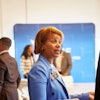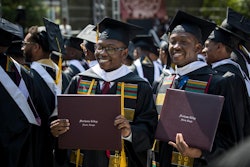A Focus on Physics
Too few African American students are choosing physics as an area of study, say Black educators
By Ronald Roach
PETERSBURG, Va.
r. James Davenport takes a great deal of pride in having taught hundreds of students who have graduated from Virginia State University with bachelor’s degrees in physics. Among graduates of the college physics program at VSU are luminaries, such as Dr. Demetrius Venable, the current chair of Howard University’s Ph.D.-granting physics program. Davenport, a veteran scientist who taught Venable and many others, sees his stewardship of VSU’s physics program as a continuation of the legacy established by early 20th century Black physicists at historically Black schools.
“The most talented Black physicists built careers at schools, such as Virginia State, Howard and Fisk because they faced discrimination at other institutions,” he says.
These days, Davenport, who is chair of the VSU physics department, worries that too few young Blacks, regardless of whether they attend historically Black schools or majority White institutions, are choosing physics as an undergraduate major and a career option with the acquisition of a Ph.D.
Historically, the lack of exposure among Black students to rigorous college prep science and mathematics courses in junior and senior high school has long limited the participation of Blacks potentially able to succeed in the discipline. In more recent years, the recruitment efforts by engineering and health science coalitions have contributed to a highly competitive environment for attracting academically prepared Blacks into undergraduate and graduate physics programs, according to observers.
Nationally, the U.S. Department of Education reports that Blacks obtaining degrees in physics in 1997 were represented as follows: associate’s degrees, 11.1 percent; bachelor’s, 5.1 percent; master’s, 4.7 percent; and doctorates, 1.9 percent.
Although a number of African American physicists acknowledge the profession has to do a better job at making Black students aware of opportunities in physics before they get to college, there also exists strong opinions that low Black student enrollment numbers represent the larger reality of a declining interest in physics by American students in general. Some critics of American public education, including Black physicists, decry the lack of quality of K-12 science education in the United States and blame the national scientific leadership for not pushing hard enough for reforms that would improve overall math and science education at the K-12 level and increase undergraduate and graduate school opportunities for U.S. students.
“There has to be more support for American-born students in the sciences,” says Dr. Keith H. Jackson, a physicist at the Lawrence Berkeley National Laboratory in California and a former Howard University professor.
HBCUs — Playing a key role
After years of coming under the threat of elimination because of low student numbers, the Virginia State University physics program currently appears safe from danger even though enrollment has stabilized at its lowest levels since the 1970s, according to VSU’s Davenport. Over the past two decades, the state of Virginia has questioned whether Virginia State’s program is justified given that it has enrolled far fewer students in physics than other state schools in Virginia.
Davenport says total enrollment hit a peak in the 1970s and 1980s at roughly 30 students. In recent years, the program has fallen to 12 to 15 majors at a given time, he notes.
Davenport explains that state officials have declined to close the VSU physics department because he has consistently shown that it is responsible for graduating more than 90 percent of Black students in physics among Virginia’s public colleges and universities.
“That’s far more than all the other Virginia campuses combined,” he says.
Because of the small size of its program, VSU is able to offer its students a considerable amount of attention, Davenport adds. That means the program is able to bring students lacking in math and science proficiency up to high levels of achievement, according to Davenport. He notes that the program has enrolled and graduated students who, prior to college, had never taken a physics course.
“We have a very strong mentoring program. We can give our students special attention because of our small numbers,” Davenport says.
Typically, most HBCU programs are considered small by large research institution standards. Faculty at several HBCUs report that they have managed to secure significant research support with federal agencies and energy laboratories. For students, that means physics research becomes a critical part of their educational experience.
“Undergraduates who come here are getting experiences that are comparable to what first- and second-year graduate students get,” Davenport says.
It is estimated that 40 percent of Blacks who earn doctorates in physics are graduates of historically Black undergraduate programs.
“The HBCUs are very productive,” says Dr. Kennedy Reed, a theoretical physicist at the Lawrence Livermore National Laboratory in California and the coordinator of an HBCU and minority-serving outreach program.
Howard’s Venable says physics programs at HBCUs have a rich tradition that began with conscientious and pioneering Black scientists. He notes that the physics Ph.D. program was the second doctorate program established at Howard, which began in 1962. Howard offered a doctorate in chemistry before the program got underway in physics, he says.
Currently, four historically Black schools have Ph.D. programs in physics. They include Howard, Hampton University, Florida A&M University and Alabama A&M University.
A Winning Collaboration?
Given the role that prominent Black scientists played in establishing physics programs at historically Black institutions, it’s not surprising that today’s associations of Black physicists and Black physics students exert some influence over the development of opportunities for African Americans, both students and faculty members, who are affiliated with programs at either HBCUs or majority White institutions.
Black officials, in particular, have been aggressive in pushing for strong ties between minority-serving institutions and federal agencies and laboratories. As a result, minority-serving institutions have benefited considerably from their alliances with agencies, such as NASA, and the national energy laboratories. In places lacking the infrastructure to allow large-scale experiments, national energy laboratories have filled a gap especially for HBCU researchers and students needing access to expensive high-tech facilities.
Lawrence Livermore’s Reed, a former president of the National Society of Black Physicists, directs the Research Collaborations Program for Historically Black Colleges and Universities and Other Minority Institutions at the laboratory. The five-year old program “develops and promotes productive and mutually beneficial scientific collaborations between the LLNL and the nation’s HBCUs and MIs,” according to program literature.
“I’ve been interested in the matter of minority underrepresentation (in physics) for quite some time,” says Reed, who launched the program in hopes of improving the scientific production of HBCUs and minority-serving institutions.
A former professor at Atlanta’s Morehouse College where he taught physics in the late 1970s, Reed joined the LLNL as a staff physicist in 1981. After noting that linkages between HBCUs and the national laboratories were often limited to student and faculty summer internships, Reed sought to develop stronger relationships between the schools and the laboratory.
“I got this program going because I wanted to have a situation where there was a link that was not limited to someone coming for the summer, but based on a professor at an HBCU having an ongoing collaboration with a national laboratory researcher. The real linchpin is the science — between scientists here at the national laboratory and the scientists at the HBCU (and minority-serving) campuses,” Reed says.
The program, which has 14 ongoing collaborations, also serves to help improve undergraduate minority student retention and long-term success in physics by getting students involved in national laboratory research that is connected to their teachers.
Reed belongs to a class of senior Black scientists who have been able to bring minority institutions and individuals into the mainstream of physics research. Physicists, such as Morehouse College president Dr. Walter Massey and Rensselaer Polytechnic Institute president Dr. Shirley Ann Jackson, have also been recognized for bringing about attention to diversity in the physics field.
The Agenda of Black Physicists
Associations, such as the National Society of Black Physicists (NSBP) and the National Conference of Black Physics Students (NCBPS), have actively pushed for Black representation in academic faculties, degree programs, and research employment and funding. Founded in 1977, the NSBP first elected officers who included Massey, who was then dean of the faculty and professor of physics at Brown University, and VSU’s Davenport as co-chairs.
Jackson, president-elect of the NSBP, says it’s highly critical for the organization to focus on increasing the numbers of Black faculty at predominately White institutions. Recently, Jackson has gotten involved with lobbying Stanford University to hire a Black physics professor. Stanford, which has enjoyed notable recognition for graduating Black doctorates in physics, unexpectedly lost Dr. Arthur Walker, previously the only Black on the physics faculty. Walker, who mentored numerous Black graduate students during his career, passed away this past April just a month after chairing a joint conference of the NSBP and NCBPS that was held at Stanford.
Jackson, who holds highly critical views of the national scientific establishment, wants to see federal agencies adopt policies to provide greater support directly to undergraduates and graduates for math and science education. He believes that U.S. federal policy supports foreign national students in the United States at the expense of native-born American students.
“We should do what the English, the Germans, the Italians and the French do, and that is to fully fund the education of undergraduates in mathematics and science,” Jackson says.
The federal government should also fund American graduate students with direct support rather than making them dependent on aligning themselves with faculty who have research grants, he urges.
A different set of policies, Jackson believes, would result in greater African American participation in physics. “There is an opportunity for us to do better, but if we don’t have the right combination of policies in place, I can’t be optimistic (about African Americans in the physics field),” Jackson says.
© Copyright 2005 by DiverseEducation.com


















